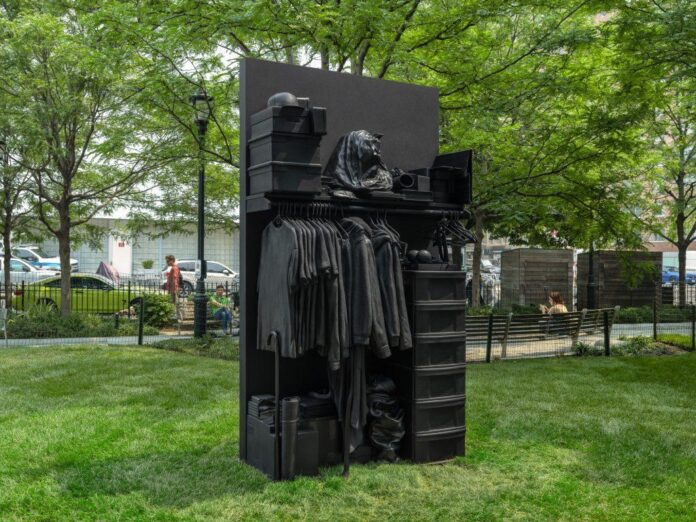An open closet now stands in New York’s AIDS Memorial Park. In it are hangers and hoodies, stacked boxes and folded weekend bags. The structure looks, in other words, like a generic storage space. It is and it isn’t.
The piece, called Craig’s Closet (2023), was created by artist Jim Hodges as a memorial to the more than 100,000 New Yorkers who have died as part of the HIV/AIDS epidemic—more than a few of whom he called friends and colleagues. It’s built to scale in granite and bronze and painted in an eerie, funereal black.
You needn’t know the name of Hodges’s sculpture to understand that it was based on a particular person. The specificity of the artwork, right down to the wrinkles on the shirts, reveals that the piece was an act of recreation rather than strict imagination. But despite the attention to detail, we still don’t know who Craig is. We don’t know their surname or relationship to the artist; we don’t know if they died or how.
Hodges, for his part, is not interested in sharing that information. He doesn’t want speculation about his relationship to the subject to distract from the universal valence of the piece.
“The personal is all evident within the work itself,” he said in an interview. “I think to expand on that narrative takes away the focus of the object and I would prefer not to do that.”
This is one of many tensions at the heart of the artwork. Craig’s Closet is intimate yet anonymous. Its material is hard but its subject matter is soft. Like most public pieces, it’s tough and heavy, built to withstand weather and crowds; but what it symbolizes is the opposite: the fragility of life.

Jim Hodges, Craig’s Closet (2023), detail. © Jim Hodges. Courtesy of the artist and Gladstone Gallery. Photo: Daniel Greer.
Hodges, who lives and works in New York, moved to the city as an upstart artist back in the mid-1980s, during the height of the HIV/AIDS epidemic. He absolutely did know many who were impacted by the crisis, including his close friend Felix Gonzalez-Torres, who died from an AIDS-related illness in 1996.
But when asked about these experiences Hodges again hedged, insisting that his sculpture points outward rather than back at himself.
He instead directed attention to the history of the site on which his artwork stands. Nearby is St. Vincent’s Hospital, a facility once referred to as “ground zero” of the AIDS epidemic, as well as to the neighborhood haunts of Greenwich Village, home to generations of artists, activists, and performers.
Hodges said the goal of the piece was to “utilize that space and its proximity and context as a kind of portal of expansion for people to enter from their own points of reference.” Fittingly, the bare back of the sculpture is reflective: “One being able to catch a glimpse of themselves in the work is important to me,” he added.
That Hodges settled on the closet, an already loaded metaphor, for his memorial says a lot about his intentions. The sculpture subverts the site as a space in which identities are concealed. Instead, it presents the closete as a kind of stage on which we place all the little tokens of our lives.
“The scene is set, and narratives blossom whenever the doors swing open,” the artist wrote in a description of his piece. “This opening gives us a reminder, an understanding of who we are, where we have been, secrets, and the dreams we hold.”

Jim Hodges, Craig’s Closet (2023), detail. © Jim Hodges. Courtesy of the artist and Gladstone Gallery. Photo: Daniel Greer.
The care with which Hodges crafted the sculpture hints at just how personal it is to him, even if he declines to talk about it. “An awful lot of love goes into making a work that you want people to feel,” he said. “That’s the standard: loving it.”
Craig’s Closet (2023) is on view now through May of 2024 in the New York City AIDS Memorial Park.

























